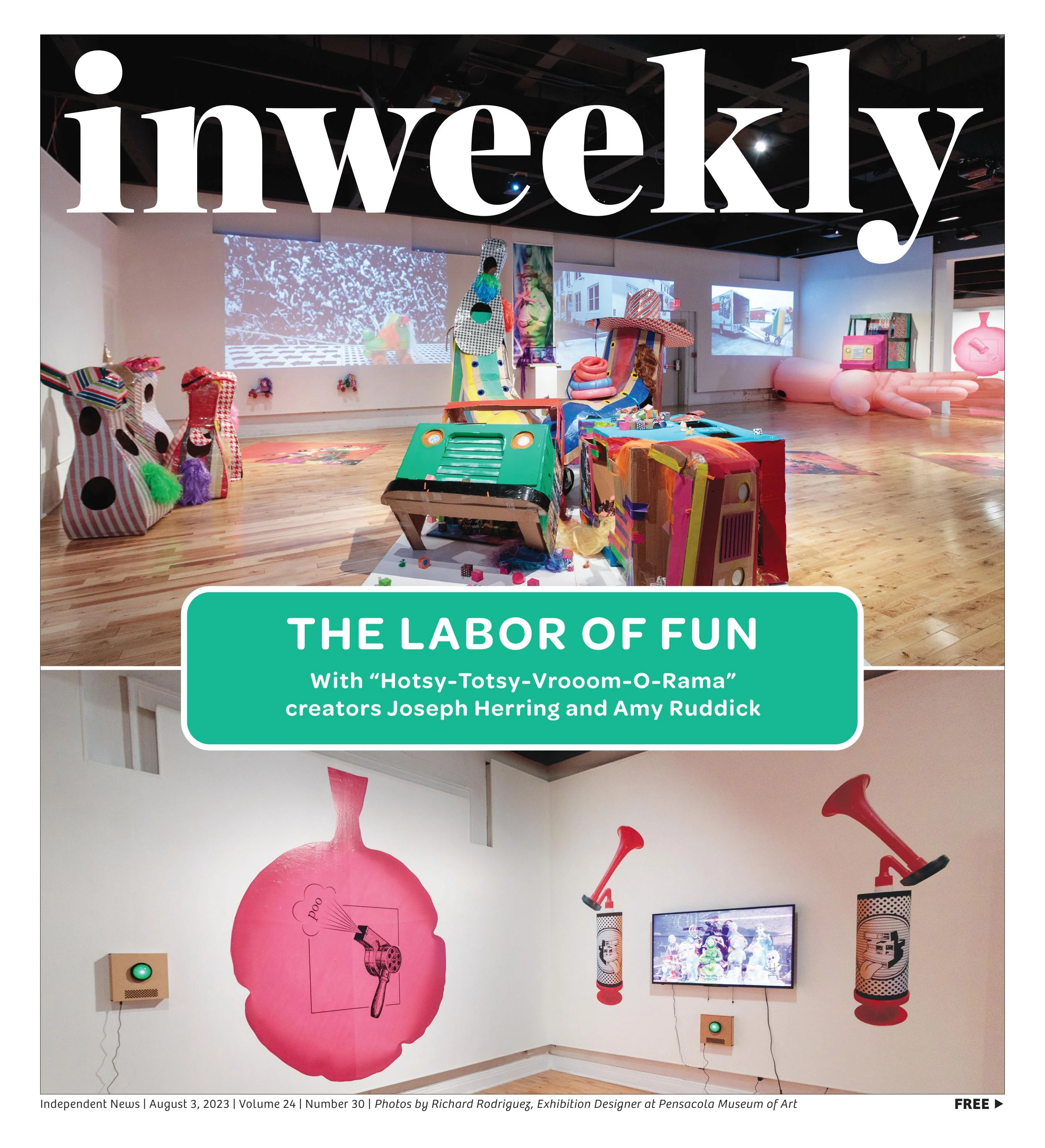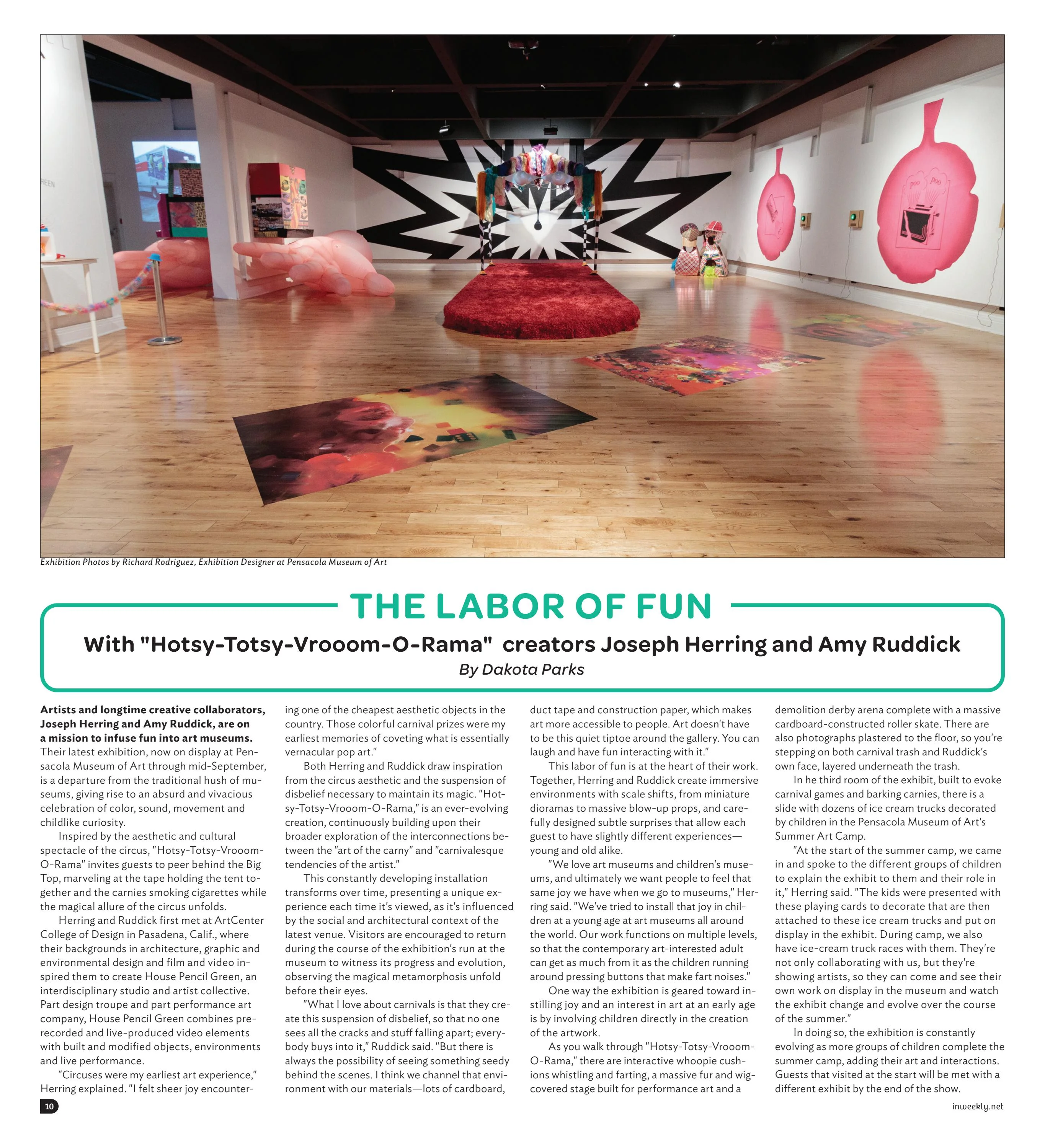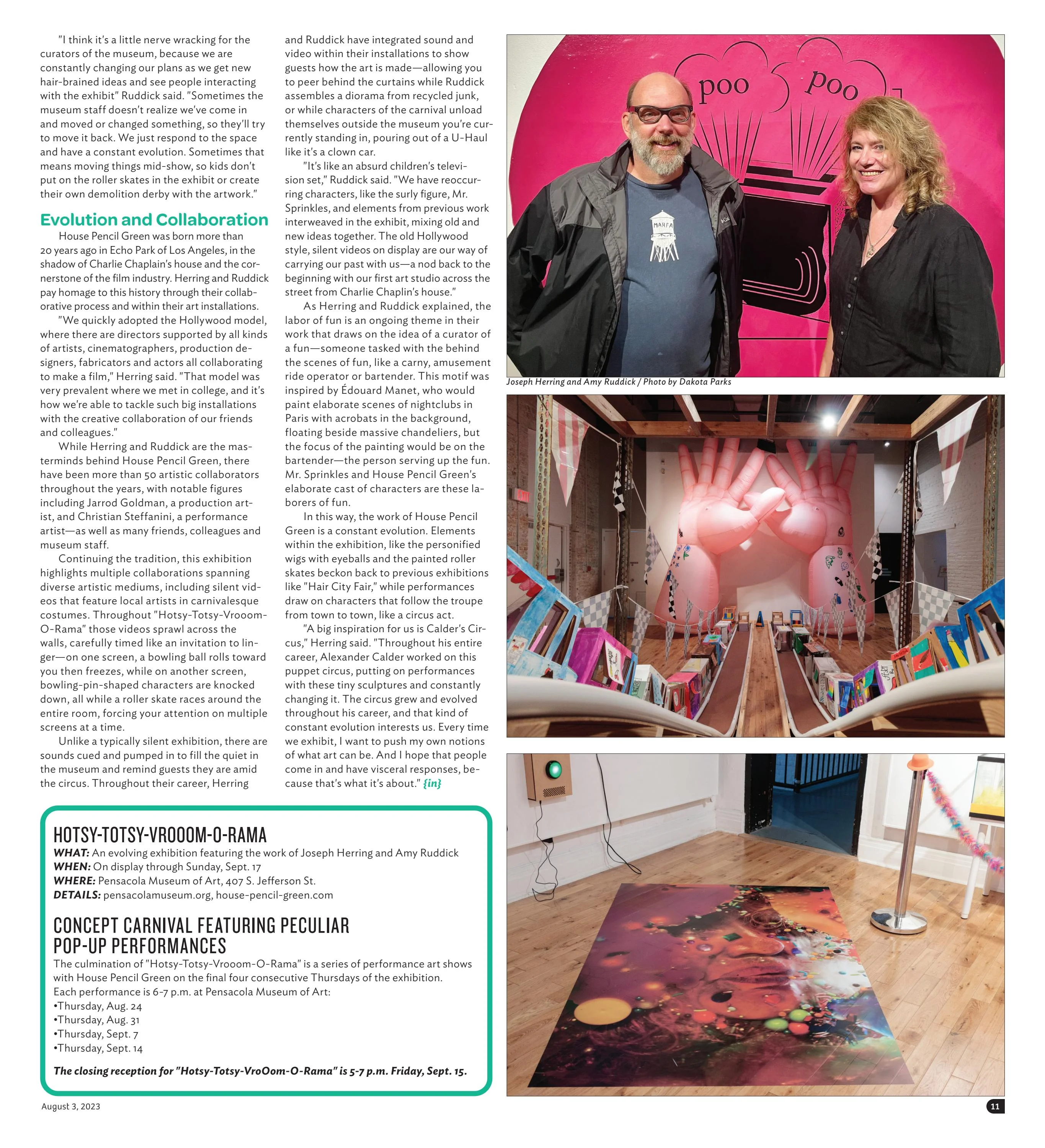By Dakota Parks for Inweekly
Artists and longtime creative collaborators, Joseph Herring and Amy Ruddick, are on a mission to infuse fun into art museums. Their latest exhibition, now on display at Pensacola Museum of Art through mid-September, is a departure from the traditional hush of museums, giving rise to an absurd and vivacious celebration of color, sound, movement and childlike curiosity.
Inspired by the aesthetic and cultural spectacle of the circus, “Hotsy-Totsy-Vrooom-O-Rama” invites guests to peer behind the Big Top, marveling at the tape holding the tent together and the carnies smoking cigarettes while the magical allure of the circus unfolds.
Herring and Ruddick first met at ArtCenter College of Design in Pasadena, Calif., where their backgrounds in architecture, graphic and environmental design and film and video inspired them to create House Pencil Green, an interdisciplinary studio and artist collective. Part design troupe and part performance art company, House Pencil Green combines pre-recorded and live-produced video elements with built and modified objects, environments and live performance.
“Circuses were my earliest art experience,” Herring explained. “I felt sheer joy encountering one of the cheapest aesthetic objects in the country. Those colorful carnival prizes were my earliest memories of coveting what is essentially vernacular pop art.”
Both Herring and Ruddick draw inspiration from the circus aesthetic and the suspension of disbelief necessary to maintain its magic. “Hotsy-Totsy-Vrooom-O-Rama,” is an ever-evolving creation, continuously building upon their broader exploration of the interconnections between the “art of the carny” and “carnivalesque tendencies of the artist.”
This constantly developing installation transforms over time, presenting a unique experience each time it’s viewed, as it’s influenced by the social and architectural context of the latest venue. Visitors are encouraged to return during the course of the exhibition’s run at the museum to witness its progress and evolution, observing the magical metamorphosis unfold before their eyes.
“What I love about carnivals is that they create this suspension of disbelief, so that no one sees all the cracks and stuff falling apart; everybody buys into it,” Ruddick said. “But there is always the possibility of seeing something seedy behind the scenes. I think we channel that environment with our materials—lots of cardboard, duct tape and construction paper, which makes art more accessible to people. Art doesn’t have to be this quiet tiptoe around the gallery. You can laugh and have fun interacting with it.”
This labor of fun is at the heart of their work. Together, Herring and Ruddick create immersive environments with scale shifts, from miniature dioramas to massive blow-up props, and carefully designed subtle surprises that allow each guest to have slightly different experiences—young and old alike.
“We love art museums and children’s museums, and ultimately we want people to feel that same joy we have when we go to museums,” Herring said. “We’ve tried to install that joy in children at a young age at art museums all around the world. Our work functions on multiple levels, so that the contemporary art-interested adult can get as much from it as the children running around pressing buttons that make fart noises.”
One way the exhibition is geared toward instilling joy and an interest in art at an early age is by involving children directly in the creation of the artwork.
As you walk through “Hotsy-Totsy-Vrooom-O-Rama,” there are interactive whoopie cushions whistling and farting, a massive fur and wig-covered stage built for performance art and a demolition derby arena complete with a massive cardboard-constructed roller skate. There are also photographs plastered to the floor, so you’re stepping on both carnival trash and Ruddick’s own face, layered underneath the trash.
In the third room of the exhibit, built to evoke carnival games and barking carnies, there is a slide with dozens of ice cream trucks decorated by children in the Pensacola Museum of Art’s Summer Art Camp.
“At the start of the summer camp, we came in and spoke to the different groups of children to explain the exhibit to them and their role in it,” Herring said. “The kids were presented with these playing cards to decorate that are then attached to these ice cream trucks and put on display in the exhibit. During camp, we also have ice-cream truck races with them. They’re not only collaborating with us, but they’re showing artists, so they can come and see their own work on display in the museum and watch the exhibit change and evolve over the course of the summer.”
In doing so, the exhibition is constantly evolving as more groups of children complete the summer camp, adding their art and interactions. Guests that visited at the start will be met with a different exhibit by the end of the show.
“I think it’s a little nerve wracking for the curators of the museum, because we are constantly changing our plans as we get new hair-brained ideas and see people interacting with the exhibit” Ruddick said. “Sometimes the museum staff doesn’t realize we’ve come in and moved or changed something, so they’ll try to move it back. We just respond to the space and have a constant evolution. Sometimes that means moving things mid-show, so kids don’t put on the roller skates in the exhibit or create their own demolition derby with the artwork.”
Evolution and Collaboration House Pencil Green was born more than 20 years ago in Echo Park of Los Angeles, in the shadow of Charlie Chaplain’s house and the cornerstone of the film industry. Herring and Ruddick pay homage to this history through their collaborative process and within their art installations.
“We quickly adopted the Hollywood model, where there are directors supported by all kinds of artists, cinematographers, production designers, fabricators and actors all collaborating to make a film,” Herring said. “That model was very prevalent where we met in college, and it’s how we’re able to tackle such big installations with the creative collaboration of our friends and colleagues.”
While Herring and Ruddick are the masterminds behind House Pencil Green, there have been more than 50 artistic collaborators throughout the years, with notable figures including Jarrod Goldman, a production artist, and Christian Steffanini, a performance artist—as well as many friends, colleagues and museum staff.
Continuing the tradition, this exhibition highlights multiple collaborations spanning diverse artistic mediums, including silent videos that feature local artists in carnivalesque costumes. Throughout “Hotsy-Totsy-Vrooom-O-Rama” those videos sprawl across the walls, carefully timed like an invitation to linger—on one screen, a bowling ball rolls toward you then freezes, while on another screen, bowling-pin-shaped characters are knocked down, all while a roller skate races around the entire room, forcing your attention on multiple screens at a time.
Unlike a typically silent exhibition, there are sounds cued and pumped in to fill the quiet in the museum and remind guests they are amid the circus. Throughout their career, Herring and Ruddick have integrated sound and video within their installations to show guests how the art is made— allowing you to peer behind the curtains while Ruddick assembles a diorama from recycled junk, or while characters of the carnival unload themselves outside the museum you’re currently standing in, pouring out of a U-Haul like it’s a clown car.
“It’s like an absurd children’s television set,” Ruddick said. “We have reoccurring characters, like the surly figure, Mr. Sprinkles, and elements from previous work interweaved in the exhibit, mixing old and new ideas together. The old Hollywood style, silent videos on display are our way of carrying our past with us—a nod back to the beginning with our first art studio across the street from Charlie Chaplin’s house.”
As Herring and Ruddick explained, the labor of fun is an ongoing theme in their work that draws on the idea of a curator of a fun—someone tasked with the behind the scenes of fun, like a carny, amusement ride operator or bartender. This motif was inspired by Édouard Manet, who would paint elaborate scenes of nightclubs in Paris with acrobats in the background, floating beside massive chandeliers, but the focus of the painting would be on the bartender—the person serving up the fun. Mr. Sprinkles and House Pencil Green’s elaborate cast of characters are these laborers of fun.
In this way, the work of House Pencil Green is a constant evolution. Elements within the exhibition, like the personified wigs with eyeballs and the painted roller skates beckon back to previous exhibitions like “Hair City Fair,” while performances draw on characters that follow the troupe from town to town, like a circus act.
“A big inspiration for us is Calder’s Circus,” Herring said. “Throughout his entire career, Alexander Calder worked on this puppet circus, putting on performances with these tiny sculptures and constantly changing it. The circus grew and evolved throughout his career, and that kind of constant evolution interests us. Every time we exhibit, I want to push my own notions of what art can be. And I hope that people come in and have visceral responses, because that’s what it’s about.”
Hotsy-Totsy-Vrooom-O-Rama WHAT: An evolving exhibition featuring the work of Joseph Herring and Amy Ruddick WHEN: On display through Sunday, Sept. 17 WHERE: Pensacola Museum of Art, 407 S. Jefferson St. DETAILS: pensacolamuseum.org, house-pencil-green.com
Concept Carnival Featuring Peculiar Pop-up Performances The culmination of “Hotsy-Totsy-Vrooom-O-Rama” is a series of performance art shows with House Pencil Green on the final four consecutive Thursdays of the exhibition. Each performance is 6-7 p.m. at Pensacola Museum of Art: Thursday, Aug. 24 Thursday, Aug. 31 Thursday, Sept. 7 Thursday, Sept. 14
The closing reception for “Hotsy-Totsy-VroOom-O-Rama” is 5-7 p.m. Friday, Sept. 15.



